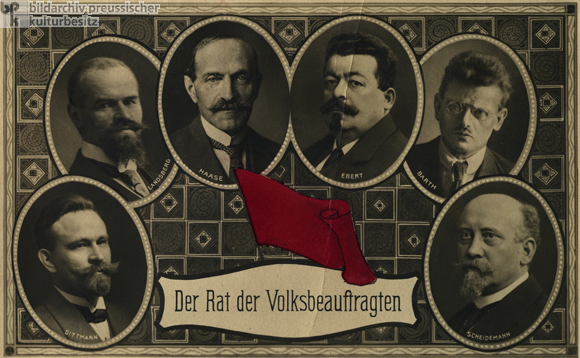













INTRODUCTION | DOCUMENTS | IMAGES | MAPS | EDITOR
|
On November 10, the SPD and USPD formed the First Council of People’s Deputies, a body in which each party had an equal number of members, including in the joint chairmanship of Friedrich Ebert and Hugo Haase. This postcard shows the council’s six members. From left to right, they are Wilhelm Dittmann (USDP), Otto Landsberg (SPD), Hugo Haase (USPD), Friedrich Ebert (SPD), Emil Barth (USPD), and Philipp Scheidemann (SPD). The revolutionary red flag contrasts with the otherwise black-and-white postcard. The Council of People’s Deputies had wide-ranging powers and took on the most urgent governmental tasks, for example, demobilization after the armistice was signed. It gained the support of the military’s leadership by concluding a pact with the army’s supreme headquarters (OHL), which gave the latter autonomy in military affairs. Soon, however, the SPD and USPD split because the latter rejected a national constitutional assembly in favor of a socialist republic organized on the basis of the revolutionary councils (often translated as “soviets” in English). After a socialist uprising during the Christmas Rebellion was put down on Ebert’s orders, the USPD council members left their positions and were replaced by two SPD deputies, Gustav Noske and Rudolf Wissell. Elections to the National Assembly were held on January 19, 1919, and that body replaced the Council of People’s Deputies. Picture postcards had been a popular medium for political messaging under the Kaiser. During the revolution, portraits of the main revolutionary figures replaced those of the Kaiser and his family, as did images of key revolutionary events, in order to underline the legitimacy of the new government. Since these postcards were primarily destined for postcard collections, many have been preserved.
© Bildarchiv Preußischer Kulturbesitz |
 print version
print version return to image list
return to image list previous image
previous image
